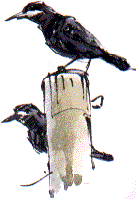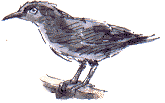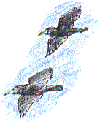 |
Sunlight on StubbleThursday 14th December 2000, West Yorkshire |
![]()
![]()
![]()
![]()
![]() Nature
Diary Rocks
History
Workshop
Links
Home Page
Nature
Diary Rocks
History
Workshop
Links
Home Page
![]()

 YOU'RE BEST wearing Wellington boots for the farm track this morning. Some of the puddles are larger than our garden pond and almost as deep. But for a change it's a cool, crisp sunny day, instead of mild, moist and dull as it has been for much of the last month.
YOU'RE BEST wearing Wellington boots for the farm track this morning. Some of the puddles are larger than our garden pond and almost as deep. But for a change it's a cool, crisp sunny day, instead of mild, moist and dull as it has been for much of the last month.I get a chance to take a good look at a flock of Rooks - 19 of them, enough for a Van Gogh painting - foraging on a field of stubble. This isn't as much of a common sight as you might imagine; I don't see rooks as often as Carrion Crows in the valley.
The rooks make their way steadily down the slope, probing the soft ground and leapfrogging each other in short, low flights. It occurs to me that they have the sun in their eyes, or, more accurately, they have the sun in front of them; their eyes are on the side of their heads, of course. If the light gives them any sort of disadvantage in keeping a watch for predators they don't have much choice about it, as there's a cool wind from the south-east blowing up the slope, which they must face into as they probe amongst the stubble for spilt grain, insects and worms . . . and the occasional rubber band (see below).

 Five Jackdaws have joined them. They keep together within a few yards of each other; one small flock in the middle of another. They're smaller than the rooks. I'm looking at them through binoculars and there's a good light but even so I can't make out some of the field marks that I'd expect to see on these two species. The jackdaw usually has a grey on the back of its head, but these appear to be glossy black all over. The rook usually has a greyish-white bald patch at the base of its bill, but it's not all that noticeable on these birds. Perhaps most of the birds in this flock are juveniles?
Five Jackdaws have joined them. They keep together within a few yards of each other; one small flock in the middle of another. They're smaller than the rooks. I'm looking at them through binoculars and there's a good light but even so I can't make out some of the field marks that I'd expect to see on these two species. The jackdaw usually has a grey on the back of its head, but these appear to be glossy black all over. The rook usually has a greyish-white bald patch at the base of its bill, but it's not all that noticeable on these birds. Perhaps most of the birds in this flock are juveniles?To me the most striking difference between the rook and the crow is that the rook has a dagger-shaped bill, broad at the base, and a noticeable 'forehead', while the crow looks like a scaled-down version of the raven, with a bill that's more like an undernourished black banana.
There's a noise of a passing train. I don't know whether that's what startles them but they get up, the rooks cawing - a rounded raucous sound that I always associate with such traditional English scenes as tall elms by country churches.

Elms have been all but wiped out by Dutch Elm Disease of course, and there are no tall trees nearby. This flock lands on the outstretched arms of an electricity pylon.
Rooks and Rubber
 I have an impression that rooks were once commoner. I remember that flocks of several hundred were a regular sight. For many years there was a large rookery in a sycamore plantation near Bretton crossroads (now a roundabout) on the Denby Dale road. But it must be 20 years since I've seen them there.
I have an impression that rooks were once commoner. I remember that flocks of several hundred were a regular sight. For many years there was a large rookery in a sycamore plantation near Bretton crossroads (now a roundabout) on the Denby Dale road. But it must be 20 years since I've seen them there.In Springtime in Britain, American naturalist Edwin Way Teale wrote;
On occasions, bushes beneath the nesting trees are festooned with . . . pieces of rubber. In the early 1930s, when the trees of one rookery near Wakefield, in Yorkshire, were felled and the area cleared by fire, a smell of burning rubber pervaded the region. The rooks apparently pick up the rubber as food, mistaking the indigestible bands and rings for something edible.
![]()
Richard Bell,
wildlife illustrator
E-mail; 'richard@willowisland.co.uk'
![]() Next page
Previous page
This day last year
Nature Diary
Home Page
Next page
Previous page
This day last year
Nature Diary
Home Page
![]()